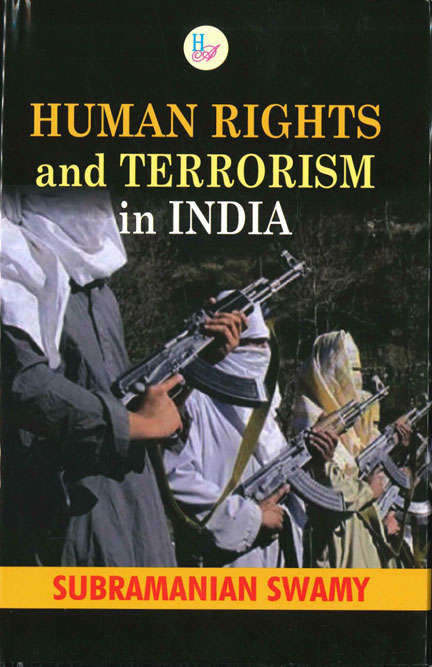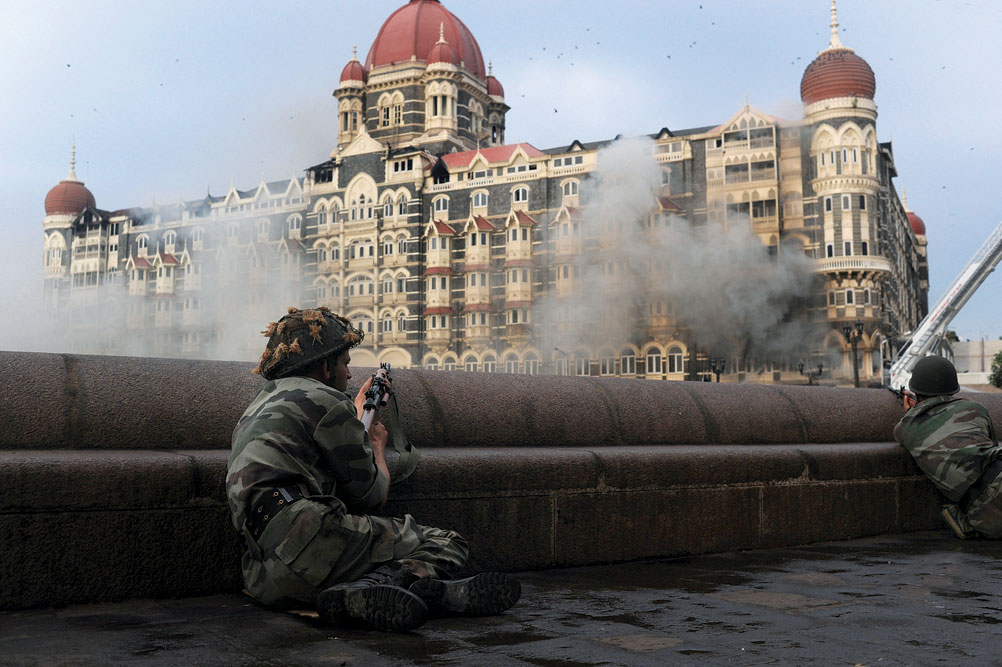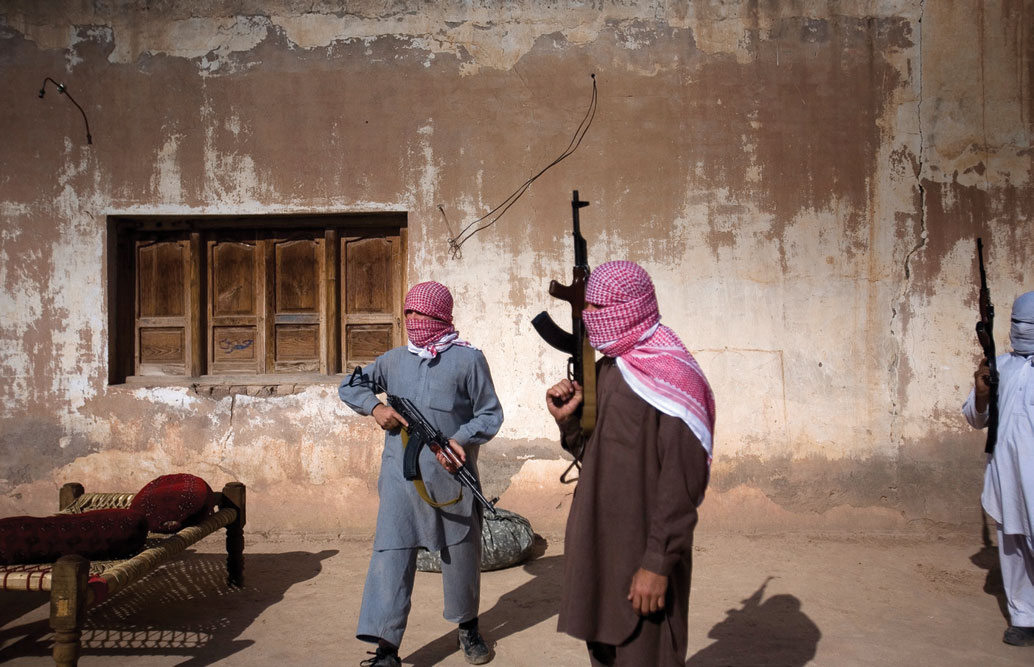The Axis of Jihad
Why the war on terror is failing
 Subramanian Swamy
Subramanian Swamy
 Subramanian Swamy
Subramanian Swamy
 |
10 Sep, 2021
|
10 Sep, 2021

/wp-content/uploads/2021/09/Jihad1.jpg)
(Illustration: Saurabh Singh)
THE QUICK AND unprecedented victory of America-led coalition forces over Iraq and Afghanistan showed that terror-sponsoring Islamic states lack formal military might. However through proxies, the remaining radical Islamic states of the globe have imposed a painful terror war on the US and its allies. Some of the more radical states such as Iran, are even at the threshold of acquiring nuclear weapon capability. By terror tactics, pressure mounted on America, with its military and economic toll more than 2 trillion dollars thus far and over 7,000 civilians and military personnel killed and several tens of thousands injured, to cut and run from Iraq and Afghanistan. Hence, the US has now washed its hands off Iraq and Afghanistan. Terrorists such as ISIS and Taliban will soon fill the vacuum by 2024. Such an outcome would be worse than British PMNeville Chamberlain’s capitulation in September 1939 to Hitler. Former US President, George Bush Jr, has recently pointed out the most regrettable decision of current US President Biden to withdraw from Afghanistan, and in effect handing over that country to Taliban.
The bitter truth is that Islamic terrorists’ offensive today, represented by the likes of Al-Qaeda, is sustaining due to the clandestine sponsorship by a de facto “Axis of Jihad” of three nations: Saudi Arabia, Pakistan and Iran. Two of these three nations are close allies of the USA!
Islam had been an expanding power until at least the 18th century, with a long history of conflict with Christianity, religion of the majority in the West. Islam and Christianity had converted the people of nations that they conquered into nearly 100 per cent Muslims or Christians. India was the exception which despite eight hundred years of Islamic and two hundred of Christian conquests has remained overwhelmingly Hindu. This fact has been a living regret for Islamic orthodoxy, while Christian foreign missionaries in India articulate the same regret more subtly. In today’s jihad contexts, without understanding the nature of Islamic tenets and this history we can never formulate an effective anti-terrorist answer. Correct answers require posing correct questions. The correct question is “What is political Islam and its theological fundamentals?”
Islamic scriptures are divided into “spiritual Islam” and “Political Islam.” Islamic trilogy—consisting of the Koran, Hadith and Sira—is the religion. Of this, political Islam is outlined in Hadith and Sira. Spiritual Islam is what Koran preaches. Political Islam, as presented in Hadith and Sira commands Muslims to conquer the world for Islam. It governs the kind of life and political system to which Muslims should adhere strictly, based on its legal code called sharia, an unchanged document that was written over a thousand years ago.
There is no room for reform since the sharia cannot be questioned. This code does not embody a spiritual philosophy, and hence there is no room for debate.
Thus, wherever Muslims felt that they had materially fallen behind, the orthodoxy was called for Muslims to embrace even more retrogressive practices of political Islam. The fundamentalists assert that once the whole world is Islamized, everyone will feel fulfilled and be at peace with one another. And those Muslims who will willingly die for this cause, including by committing suicide, will go to a “heaven” resembling an Islamic Las Vegas.
Hence, the agenda set by political Islam for believing Muslims is spawning of terrorism and is at the root of it.
The doctrine of jihad is the most important tool that political Islam uses to assert its influence and achieve its vision. The term jihad in the Islamic trilogy describes two concepts: there is jihad as an inner struggle, whose aim is to please the almighty God by spiritual purity and then there is jihad as external warfare, aimed at conquest of unbelievers and the imposition of Islam on its inhabitants. Armed warfare imposed on unbelievers is one acceptable form of jihad. In Bukhari Hadith, the most respected of Hadiths, 97 per cent of the jihad references are about war and only 3 per cent are about the inner spiritual struggle.
Pakistan’s orthodoxy, regarding their nation as the torchbearer for Islam in South Asia, sees the largest nation in the region, the Hindu majority India, as the stumbling block for extending Islamic boundaries. Although Sunni-majority Pakistan was frustrated by its smaller size and lack of resources, it has an extensive track record of jihad dating back to 1947. Even without Saudi funding, between 1947 and 1980, Pakistan has been a nation committed to selective killings of non-Muslims or their displacement as part of a jihad. Generous jihad funding from Saudi Arabia (which is also predominantly Sunni) since the mid-1970s has made Pakistan a powerful den of Islamic orthodoxy. The secular urbanized Pakistani community is a wholly marginalized segment of society.
Perhaps more than any other Islamic nation, Pakistan has acted as a collaborator for Saudi Arabian ideologues of Wahhabi Islam, and a translator of jihad plans into action; it has provided logistics, training and know-how for jihadist movements around the world. For instance, financially, aided by Saudi Arabia, the Afghan Taliban was Pakistan’s creation.
Former US President, George Bush Jr, has recently pointed out the most regrettable decision of current US President Biden to withdraw from Afghanistan, and in effect handing over that country to Taliban. The bitter truth is that Islamic terrorists’ offensive today, represented by the likes of Al-Qaeda, is sustaining due to the clandestine sponsorship by a de facto ‘Axis of Jihad’ of three nations: Saudi Arabia, Pakistan and Iran. Two of these three nations are close allies of the USA!
When it quickly became apparent that Al-Qaeda was behind the 9/11 attacks, a vastly superior American military invaded Afghanistan and quickly toppled the Taliban and Al-Qaeda from power, with the help of anti-Taliban Northern Alliance. But poor politics, and Pakistan’s complicity, allowed the toppled Al-Qaeda and Taliban leadership including the late Osama bin Laden, to escape to safe sanctuary in neighbouring areas of Pakistan.
However, bin Laden, Al-Qaeda, the Taliban are sequential symptoms of a resurging political Islamic movement, adhering to Sunni or Shia fundamentals, and nurtured by powerful financial entities in Saudi Arabia, through Hizbullah sponsored by Shiite Iran. The war on terror therefore has to focus not on the proxies, like Al- Qaeda or Hizbullah, but on confronting and neutralizing the terrorist nests and incubators in the “Axis of Jihad”nations.
Thus, “political” Islam and its core concept of jihad have spread throughout the world invigorated by the financial sponsorship of three nations: Saudi Arabia, Iran and Pakistan, the “Axis of Jihad.” This axis has a common vision despite other deep differences, viz conquest of unbelievers and their lands, and the active or complicit sponsorship of terror as a long-standing instrument to further this Islamic vision.
The more secular Islamic states, such as Syria, had originally used terrorism as part of military and foreign policy strategy, but not as a jihad tool. But today, in terms ideological commitment, and jihad-sponsorship, the “axis” nations are the de facto leaders and while other Islamic states such as Syria are willing or reluctant followers.

In June 2006, a Pew Global Attitudes poll showed that a majority of Muslims in Jordan, Egypt and Nigeria, as well as roughly a third of Muslim residents in France, Spain and Great Britain, felt violence against civilians can be justified in order to defend Islam. Of course, it is left to medieval clerics, who are invariably extremists, to define when and where Islam needs to be defended. Thus, from a practical perspective, this poll indicates that a majority of Muslims in many Muslim nations support terror against non-Muslim civilians. Perhaps, the least enthusiastic about political Islam amongst Muslims are those resident in India. The recent and repeated targeting of Muslims in terrorist bombings, such as in Masjids of Nasik and Hyderabad may be to bring the Muslims of India in line with the tenets of the Hadith and Sira.
The terrorist outfit, Al-Qaeda, has issued an open warning to India saying that the country should be “ready” to see “a series of terror attacks on Indians,” of course targeting Hindus but unconcerned if Muslims too die. In a video issued in July 2007, featuring Adam Yahiye Gadahn—an American Al-Qaeda member—the terrorist said in that video that Indian and American diplomatic missions all over the world are their legitimate targets. “We shall continue to target you at home and abroad just as you target us at home and abroad,” he added.
From a policy perspective, the ability of a terrorist-targeted nation to put political goals of terrorists at risk stands the best chance at deterring and, hence, becomes the most important objective of counter-terrorism policy. But the contours and structure of a counter-terrorism policy, and the selection of instruments for implementation of the policy, have to be nation-specific and terrorist organization-centric. There cannot, therefore, be a general global strategy of deterrence against terrorism
He accused India of killing more than a hundred thousand Muslims in Kashmir with “US blessing.” The video, one hour and 17 minutes long also has Gadahn warning President Bush to withdraw his troops from Muslim lands or he can expect worse than September 11. Responding to the threat message by Al-Qaeda, junior Home Minister Sri Prakash Jaiswal blandly told the media that “despite reports from the media, we haven’t received any official confirmation [sic] regarding the threats. But our country, our paramilitary forces, out security forces are ready to combat any attack of any kind,” he added. But earlier, in a TV 18 network exclusive, National Security Advisor, MK Narayanan told Karan Thapar that Al-Qaeda was looking for an opportunity to strike in India and had even done the necessary reconnaissance for it.
Hence, the blinkers should be cast aside, and we should see the terrorist threat to India, without equivocation and temporizing, as against especially the Hindu civilization. This is the target of Islamic terrorism, and India is being besieged by it and helped by nation- state sponsors abroad as also its videos within our nation. Our current de facto strategy of absorbing the costs of terrorism by an attitude of “business as usual” will simply not work. India needs a counter-terror strategy that deters terrorists from thinking of bleeding our nation, and suffers unbearable costs for terror attacks.
As an essential component of this deterrence strategy, we need a pack of adequate constitutionally valid anti-terror legislation, which we lack today.
A number of mature democracies such as the US, UK, France, Germany, Australia, and New Zealand—all with a track record on human rights—have enacted new laws or tightened existing ones to give greater backing to their counter-terror operations (US’ record on Guantanamo Bay and Abu Ghraib cannot be cited since these were treated as war camps).
In India, where terror has taken a much bigger toll than in any of these countries, special laws were initially enacted and then withdrawn as they were found to be “draconian.” Was that right? Are not special laws for the purposes of fighting terror necessary?
In India, the dimension of terror sponsors are many—it has neighbours like Pakistan and Bangladesh, where terror groups like JeM, LeT and HuJI find shelter, and perhaps much more. Besides, there are no racial distinctions between the operatives of these groups and Indians, unlike in Western democracies. On top of this, there are pockets in the country which appear to have been influenced by extremist doctrines; thus, it’s not as difficult to find logistical support in India as it is in Western democracies.
Yet in India we are still shying away from doing any of this in the fear that the wider powers given to agencies would be abused.
Since the terrorist threat to India has become multidimensional and complex, the question is whether one can devise a counter-terrorist deterrence strategy. Most prominent national security analysts have argued that deterrent strategies are difficult to formulate and any that is devised will have no significant impact in countering the terrorist threat. For example, Richard Betts writes that deterrence has “limited efficacy…for modern counter-terrorism.” The 2002 Rand Corporation study on terrorism asserts, “The concept of deterrence is both too limiting and too naïve to be applicable to the war on terrorism.” And the belief that traditional deterrence is inadequate as a counterterrorist strategy is also shared by President George W Bush and his administration and whose National Security Strategy documents state: “Traditional concepts of deterrence will not work against a terrorist enemy.”

This overwhelming consensus has now been convincingly challenged by Robert Trager and Desseslava Zagorcheva, two US based scholars in their study (“Deterring Terrorism—It can be Done,” International Security Journal, Harvard-MIT, Vol 30, No 3, 2006).
According to these two scholars, the case against the utility of deterrence strategies in counter-terrorist campaigns appears to rest on three pillars. First, terrorists are thought to be irrational, and therefore unresponsive to the cost-benefit calculation required for effective deterrence. Second, many terrorists are said to be so highly motivated that they are willing to commit suicide for the cause and so not deterred by fear of death or punishment or of anything else. Third, even if terrorists were afraid of punishment, they cannot be deterred because they lack a return address, and hence no retaliation can be visited upon them. If terrorists cannot be found, thinking of use of force against them, it is contended is useless. Also ineffective are counter-terrorist strategies of Liberals in which is advocated addressing the “root causes,” and by “winning hearts and minds” by providing economic packages and promoting human rights, obviously as a long-run solution. As John Maynard Keynes had once said of the “long run”: “We could be all dead by then.”
The secular urbanized Pakistani community is a wholly marginalized segment of society. Perhaps more than any other Islamic nation, Pakistan has acted as a collaborator for Saudi Arabian ideologues of Wahhabi Islam, and a translator of jihad plans into action; it has provided logistics, training and know-how for jihadist movements around the world
Trager and Zagorcheva have argued that the claim—that deterrence is ineffective against terrorists—is wrong. Their central thesis is that even the most highly motivated terrorists can be deterred by instead holding at risk their political goals, rather than their life, liberty or property.
From a policy perspective, therefore, the ability of a terrorist-targeted nation to put political goals of terrorists at risk stands the best chance at deterring and, hence, becomes the most important objective of counter-terrorism policy. But the contours and structure of a counter-terrorism policy, and the selection of instruments for implementation of the policy, have to be nation-specific and terrorist organization-centric. There cannot, therefore, be a general global strategy of deterrence against terrorism.
We advocate for India deterrence as our primary strategy. Other strategies may be tried as supplementary and secondary, and sequenced properly.
High levels of motivation often make terrorists highly susceptible to a deterrence strategy that targets their political goals. Highly motivated terrorists, because they hold their political goals dear, are reluctant to run even low-level risks that hurt their political aims. This magnifies the coercive leverage of strategies that target political ends. Herein thus lies the clue on how to deter terrorism: a strategy to hurt the terrorists political goals.
Terrorists are encouraged by appeasement but never satisfied by it. Therefore, no matter how many Hindus have to die for it, the basic policy has to be: never yield to any demand, however small, of the terrorists. That necessary resolve has not been shown in our recent history. Instead ever since we conceded Pakistan in 1947 under duress, we have been mostly yielding time and time again to threats and violence.
In 1989, to obtain the release of Mufti Mohammad Sayeed’s daughter, Rubaiyya, who had been kidnapped by terrorists, five terrorists in Indian jails were set free by VP Singh’s government. This made these criminals in the eyes of Kashmiri separatists and fence-sitters as heroes, as those who had brought lndia’s “Hindu establishment” on its knees. To save Rubaiyya, it was not necessary to surrender to terrorist demands. There were other ways. But the then government was capitulationist in outlook, [and] did not explore them.
In 1991, when Chandrashekhar was PM, and I was his senior Minister also handling the Law and Justice portfolio, the former Water Resources Minister at the Centre Saifuddin Soz’s daughter was similarly kidnapped by the JKLF. They too made the same demand [release of four terrorists in jail] but we refused. We also took some secret retaliatory action which frightened the JKLF and hence Soz’s daughter was put on an auto-rickshaw and sent home unharmed within two days of our counter-threat which would have set back their political aims. This toughness was shown at a time when our government was tottering and about to fall! The difference with the VP Singh government was thus in the Chandrashekhar government’s mindset: it had become clear from day one to the JKLF that we meant business as also that two can play the game.
(This is an edited excerpt from Human Rights and Terrorism in India by Subramanian Swamy)

/wp-content/uploads/2025/05/Cover-War-Shock-1.jpg)












More Columns
On Being Young Surya San
Why Are Children Still Dying of Rabies in India? V Shoba
India holds the upper hand as hostilities with Pakistan end Open